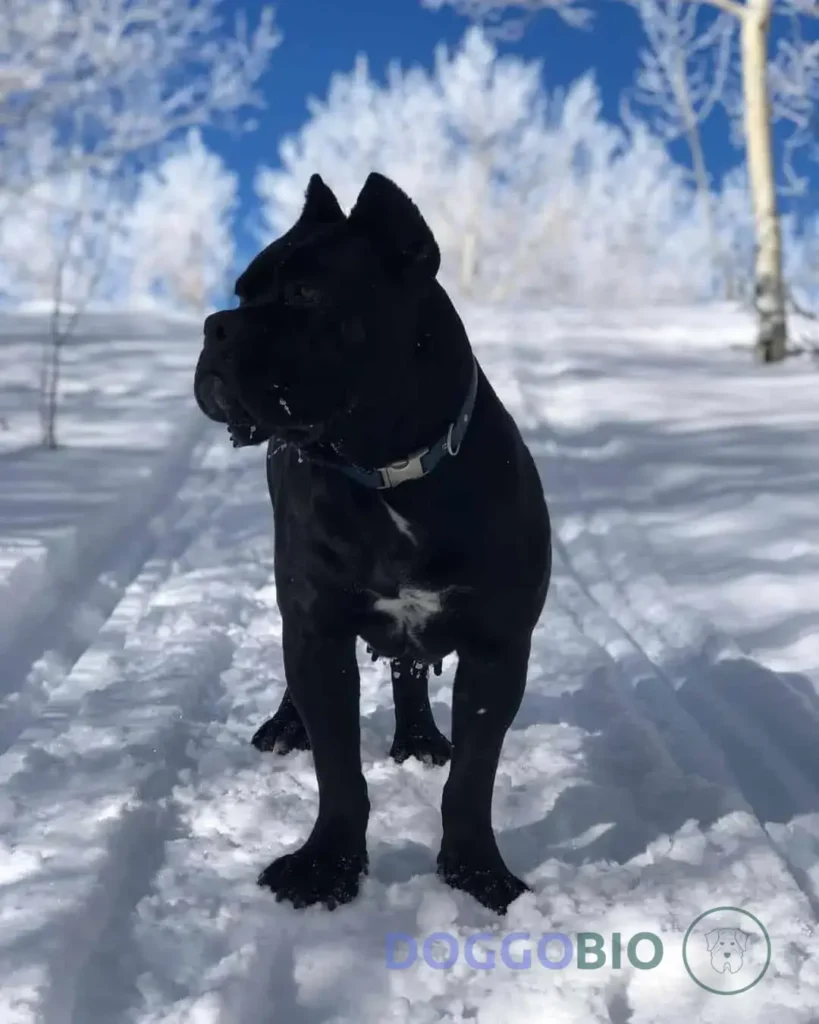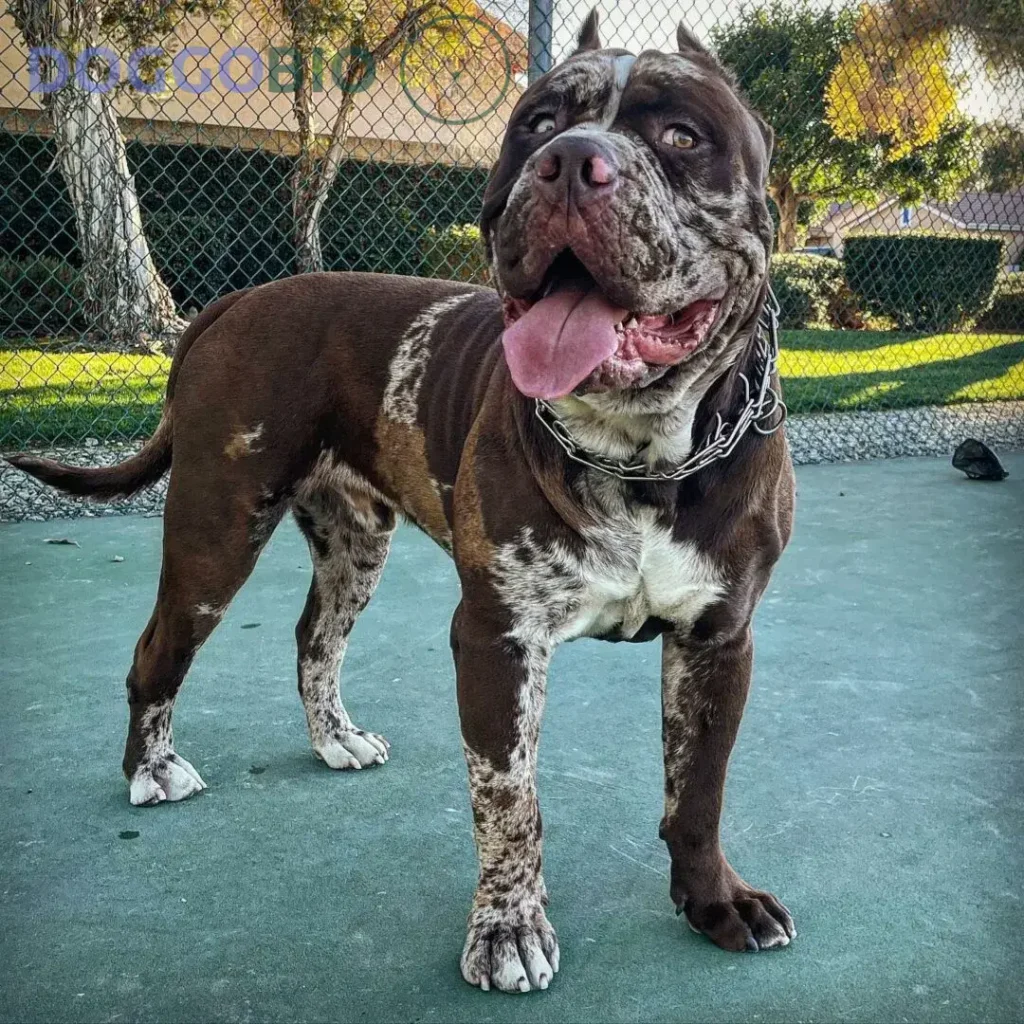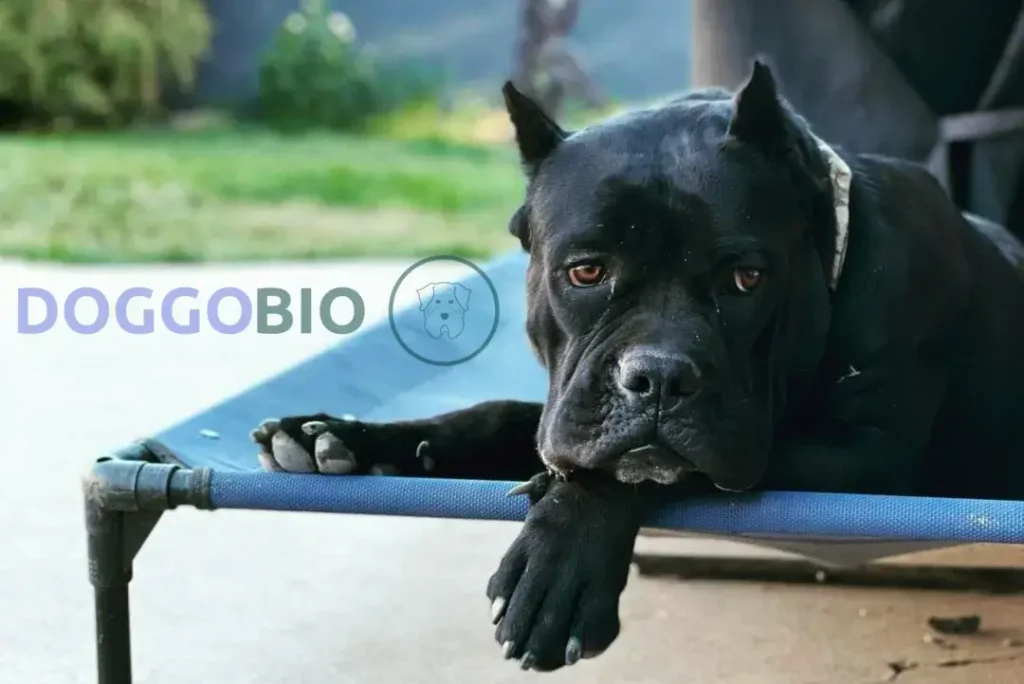Welcome to the world of magnificence and might, where a canine presence commands attention and respect: the North American Mastiff. This remarkable breed is a testament to the enduring bond between humans and dogs, characterized by loyalty, strength, and an inherent desire to protect. With a lineage deeply rooted in history, these gentle giants have evolved into cherished companions and steadfast guardians.
In this exploration, we delve into the captivating realm of the North American Mastiff, unraveling its origins, exceptional traits, and the profound role it plays in the lives of those fortunate enough to share their journey with this majestic dog breed.
A Brief Overview of North American Mastiff
| Category | Information |
| Origin | United States |
| Size | Giant |
| Weight | Males: 160-230 lbs (73-104 kg), Females: 120-170 lbs (54-77 kg) |
| Height | Males: 30-34 inches (76-86 cm), Females: 27-30 inches (69-76 cm) |
| Lifespan | 8-10 years |
| Coat | Short, smooth, single |
| Color | Fawn, apricot, brindle, merle, black, chocolate, blue, often with white markings |
| Temperament | Gentle, loyal, protective, patient, playful, calm, can be stubborn |
| Activity Level | Moderate |
| Trainability | Moderate, requires patience and positive reinforcement |
| Good with Children | Yes, with proper socialization and supervision |
| Good with Other Pets | Can be, with proper socialization, but individual temperaments vary |
| Health Concerns | Hip dysplasia, elbow dysplasia, bloat, entropion, ectropion, cardiomyopathy, cherry eye |
What is a North American Mastiff?

The North American Mastiff is a giant dog breed with a big heart. It is a cross between the English Mastiff and the Anatolian Shepherd.
This breed was developed to be a healthier alternative to the English Mastiff, with the added benefit of being a low drooler. Their calm demeanor, combined with their imposing size, makes them excellent guardians for homes.
History of American Mastiff
History is replete with tales of powerful guardian dogs, and the Mastiffs have always been central to such narratives. These colossal dogs, known for their formidable presence, have been companions to warriors, royalty, and common folk.
The North American Mastiff’s tale began in the 1980s when Ohio-based breeder Fredericka Wagner embarked on a mission. Her ambition was to craft a healthier and refined version of the Mastiff. By crossbreeding English Mastiffs with Kangal Shepherds, she aimed to mitigate common health issues and the trait of excessive drooling.
The birth of the North American Mastiff marked the realization of Wagner’s dream, and the breed quickly rose to prominence.
What does a North American Mastiff look like?

Size, height, and Weight
The sheer size of the North American Mastiff is enough to make anyone take a second look.
- Males, with their towering height of 28-36 inches, can weigh a hefty 160-200 pounds.
- Females, while slightly smaller, standing between 26-34 inches, tip the scales at 140-180 pounds.
Their size is a testament to their lineage, combining the bulk of the English Mastiff with the stature of the Anatolian Shepherd.
Coat colors and Types
The coat of the American Mastiff is a sight to behold. Standard colors adorn this breed include shades of fawn, rich browns, apricots, and ever-majestic black.
The rarer brindle and merle patterns offer a stunning alternative for those looking for something even more unique.
Temperament and Personality
Beneath the North American Mastiff’s imposing exterior lies a heart of gold. Despite their size, these dogs are known for their calm and affectionate nature.
They form strong bonds with their families, often becoming fiercely protective. Their gentle nature makes them excellent companions for children, while their innate courage ensures they are always ready to protect their loved ones.
They are also known to be tolerant and quiet, preferring a peaceful coexistence with other pets in the household.
Training and Exercise Requirements
The American Mastiff, with its strong will and independent nature, can pose a challenge for first-time dog owners. Training requires a firm yet patient hand. Consistency is key, and early socialization can work wonders.
As for exercise, while they might not be the most energetic breeds, they benefit from regular, gentle walks. This not only keeps them fit but also provides essential mental stimulation.
Grooming and Cleaning
The American Mastiff’s coat, while majestic, is relatively low maintenance.
- A weekly brushing session is usually enough to keep it in top condition.
- Bathing, on the other hand, can be done every two months or so.
- However, regular checks on their nails, ears, and teeth are essential to ensure their overall well-being.
Food and Diet
Feeding a giant breed like the American Mastiff requires careful consideration. A diet rich in protein and essential vitamins and minerals ensures they remain healthy and active.
While they do have hearty appetites, care should be taken to avoid overly fatty foods, which can lead to obesity and related health issues.
Life Expectancy and Common Health Issues
The American Mastiff, when provided with proper care and attention, can lead a fulfilling life spanning 8 to 12 years.
This life expectancy is relatively standard for breeds of its size. However, like all breeds, they are susceptible to specific health issues.

1. Joint dysplasia
This condition, common in larger breeds, affects the hip and elbow joints. It can lead to arthritis and pain if not addressed early. Regular check-ups and maintaining a healthy weight can mitigate the risks.
2. Pulmonic Stenosis
A congenital heart defect, pulmonic stenosis, is when the flow of blood from the heart’s right ventricle to the pulmonary artery is restricted. Early detection and treatment are crucial.
3. Bloat
Also known as gastric torsion, this life-threatening condition occurs when the stomach fills with gas and twists on itself. It’s essential to recognize the symptoms early and seek immediate veterinary care.
4. Skin issues
Due to their short coat, American Mastiffs can be prone to various skin conditions, including allergies and infections. Regular grooming and check-ups can help identify and treat these issues promptly.
5. Hypothyroidism
This is a condition where the thyroid gland doesn’t produce enough hormones, leading to issues like obesity, lethargy, and skin conditions. It’s manageable with medication and regular monitoring.
6. Bone cancer
Osteosarcoma, a type of bone cancer, is more prevalent in larger breeds. Early detection and treatment are vital.
7. Heart diseases
American Mastiffs can be prone to certain heart conditions like many large breeds. Regular check-ups can help in early detection and management.
8. Cataracts
This condition leads to cloudiness in the eye’s lens, affecting vision. It’s essential to monitor any changes in the dog’s eyesight.
9. PRA (Progressive Retinal Atrophy)
A degenerative eye disorder, PRA can lead to blindness. Regular eye check-ups can help in early detection.
10. Bone deformities
Due to their rapid growth, some American Mastiffs might develop bone deformities. A balanced diet and regular vet visits can help monitor and manage this condition.
11. Ectropion
This condition causes the lower eyelid to droop or roll out, leading to potential irritation or infections. It might require surgical correction in severe cases.
12. Entropion
The opposite of ectropion, entropion, causes the eyelid to roll inward. This can lead to the eyelashes rubbing against the eye, irritating. Surgery might be necessary in some cases.
How Much is a North American Mastiff?
For those looking to welcome an American Mastiff into their homes, prices typically range from $1,000 to $1,500.
However, it’s essential to remember that the initial cost is just the beginning. Proper care, including food, medical expenses, and training, can add up over time.
How Can I Find an American Mastiff For Sale?
The burgeoning popularity of the American Mastiff has led to a surge in breeders. However, it’s imperative to prioritize quality over quantity. Undertaking thorough research and opting for reputable breeders ensures the dog’s well-being is at the forefront.
Is this breed the Right Dog for You?

Introducing an American Mastiff into one’s life is a momentous decision. Their size, coupled with their distinct needs, may not be the ideal fit for everyone.
However, for those equipped to cater to their requirements, the rewards, in terms of unwavering loyalty and companionship, are boundless.
Frequently Asked Questions
What breed makes an American Mastiff?
The American Mastiff is a unique blend, primarily derived from the English Mastiff and the Anatolian Shepherd. This combination was intentionally bred to produce a healthier variant with reduced drooling and specific desired traits.
What is the difference between a Cane Corso and a Neo Mastiff?
While both breeds are part of the Mastiff family, the Cane Corso originates from Italy and was historically used as a guard, hunter, and war dog.
The Neapolitan Mastiff, often called the Neo Mastiff, is also Italian and known for its loose, wrinkled skin and a more massive build.
Both breeds have distinct temperaments and physical characteristics.
What is the difference between an English Mastiff and a North American Mastiff?
The difference between an English Mastiff and a North American Mastiff lies in their origins, traits, and purpose.
- Lineage: The English Mastiff boasts ancient roots, dating back to Roman times, while the North American Mastiff is a newer breed, born from crossing the English Mastiff with the Anatolian Shepherd.
- Physical Traits: While both are robust, the North American Mastiff may inherit some characteristics from the Anatolian Shepherd, resulting in slight variations in appearance.
- Drooling: Distinctively, the North American Mastiff aims to minimize drooling, a trait common in English Mastiffs.
- Temperament: While gentle, the North American Mastiff may exhibit heightened protective instincts from its Anatolian Shepherd lineage.
- Health: Mixing with the Anatolian Shepherd may alter health risks in the North American Mastiff compared to its English counterpart.
Ultimately, the North American Mastiff embodies a blend of heritage and refinement, offering unique attributes alongside its Mastiff lineage.
Does AKC recognize American Mastiff?
No, the AKC does not recognize the American Mastiff. While the American Kennel Club (AKC) has not officially acknowledged the American Mastiff as a distinct breed, other organizations such as the Continental Kennel Club (CKC) and the American Pet Registry Inc. (APRI) do recognize it.
Is a Mastiff Aggressive?
No, a Mastiff is not inherently aggressive. While Mastiffs are naturally protective and might display caution around unfamiliar individuals, they are typically gentle giants.
Providing them with proper socialization and training from an early age is essential to fostering a balanced and friendly temperament.
Is Mastiff a working dog?
Yes, Mastiffs have a history as working dogs. In the past, Mastiffs were employed for various roles, including guarding, hunting, and participating in battles.
In contemporary times, although they are predominantly kept as companion pets, their innate protective instincts qualify them as effective guard dogs.
Can American Mastiffs Be Guard Dogs?
Yes. Their natural protective instinct, combined with their imposing size, makes them effective guard dogs. However, it’s essential to ensure they are adequately trained and socialized.
Are mastiffs good for first-time owners?
No, Mastiffs might not be the best choice for first-time owners. While Mastiffs are known for their loyalty and gentle nature, their sheer size and strength can pose challenges.
With adequate training and a deep understanding of the breed, novice dog owners might find managing them more manageable.
Do American Mastiffs Get Along With Other Pets?
Yes, North American Mastiffs generally get along with other pets. When properly socialized from an early age, American Mastiffs can live harmoniously with other animals, whether dogs or cats. However, early introduction and consistent monitoring are essential for peaceful coexistence.
Are American Mastiffs Good with Kids and Babies?
Yes, they are known to be gentle and protective of children. However, due to their size, supervision is recommended during interactions with young kids.
Is a Mastiff Easy To Train?
Yes, Mastiffs are relatively easy to train. Mastiffs generally respond well to training due to their intelligence and desire to please.
However, they can exhibit an independent streak, which might present some challenges. Employing consistent methods and using positive reinforcement techniques are essential for practical training.
How Long Can a North American Mastiff Live?
A North American Mastiff can live anywhere from 8 to 12 years with proper care.
Do American Mastiffs Shed A Lot?
Yes, American Mastiffs do shed. While they possess a short coat, American Mastiffs can shed notably, particularly during specific shedding periods. Engaging in routine grooming can assist in controlling and reducing the amount of shedding.
Are American Mastiffs hypoallergenic?
No, American Mastiffs are not hypoallergenic. While they have a short coat, American Mastiffs can still produce allergens like dander, triggering allergic reactions in sensitive individuals.
It’s always recommended for potential owners with allergies to spend time with the breed to gauge their reactions before committing.
Conclusion
Navigating the realm of the North American Mastiff offers insights into the marvels of selective breeding. With its harmonious fusion of might and mildness, this breed promises to be a steadfast companion and guardian.
For those willing to invest their time and resources, the American Mastiff symbolizes unwavering loyalty, formidable strength, and boundless love.
